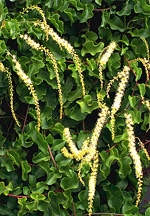 |
No species of the small family Basellaceae are native to Australia, even though the family is widely distributed from tropical America and Africa through southern Asia to Papua New Guinea. The only representative is Anredera cordifolia, a garden escape that is occasionally found in disturbed areas and margins of moist forests from south-eastern South Australia to eastern Queensland. Malabar Spinach (Basella alba) is sometimes cultivated as a vegetable in warm parts of Queensland and New South Wales, and may perhaps occasionally escape also.
Characteristic features of the family Basellaceae in Australia include: - tender, glabrous scrambling vine with twining stems and (often) knobbly, potato-like aerial tubers formed in leaf axils
- flowers white, honey-scented, bisexual, with 5 stamens in axillary, sometimes branched racemes
- ovary superior; fruit indehiscent, bearing wings or ribs formed from the persistent perianth
Description
Perennial herbaceous vines climbing by twining stems and perennating by tubers. Vegetative reproduction by tubers or bulbils. Stem internodes terete, oval or slightly flattened. Internal secretions not obvious. Plants glabrous. Leaves alternate and spiral, cauline, petiolate. Stipules absent. Lamina simple, symmetric, lanceolate or ovate; base cordate; margins entire, ±flat; venation pinnate, with the midrib conspicuous, and the tertiary venation not reticulate; surfaces not punctate; herbaceous or succulent. Plants with all flowers bisexual. Inflorescences axillary, consisting of racemes. Bracts and bracteoles present. Flowers fragrant; stalked. Floral disc absent; nectaries absent. Free hypanthium present. Perianth regular, of 1 whorl only, with 5, fused, petaloid segments, imbricate in bud, bell-shaped, white, without contrasting markings, herbaceous. Fertile stamens 5, opposite to and at least partly fused to the perianth, free of the ovary and style, distinct from each other or fused by their filaments into an open or closed tube; all ±equal. Anthers dorsifixed, versatile, opening by longitudinal slits; 2-celled. Ovary superior and sessile. Carpels 3, fused; ovary initially 3-locular, becoming 1-locular at maturity. Style terminal, single and branched above. Ovules 1 per locule, stalked; placentation basal. Fruit a dry or somewhat fleshy indehiscent utricle; the perianth on the maturing fruit dry and persistent or growing larger. Disseminule macro-surface winged. Seeds 3 per fruit. Cotyledons 2. Aril absent. Embryo ?curved or coiled.
(Note: this description has been generated from the coded data compiled for the key. Any errors in the key data will be reflected in the descriptions.)
A treatment of the family Basellaceae has not yet been published in the Flora of Australia. It will appear in Volume 5.
Australian genera of Basellaceae (as recognised for the Flora of Australia)
* = all species introduced
*Anredera

|
  |

Anredera cordifolia (flowers)
Photo: K.Thiele © K.Thiele
|

| |